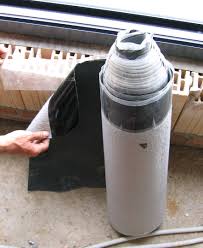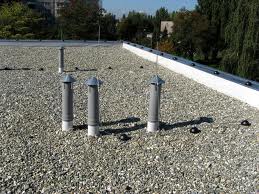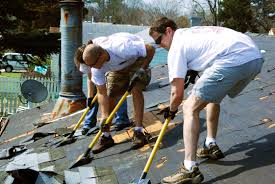Archive for April, 2014
Spring Storms and your Roof

In some parts of the country springtime brings on severe thunderstorms. Checking for damage from winter storms and snow weight now could save you in repairs instead of replacing an entire roof. The cool sunny days are good times for inspecting your roof to determine if it will withstand the high winds and heavy rains for at least one more year.
If you are able to get on a ladder you can survey your rooftop by standing on the top rungs and using binoculars. You want to look for missing, raised or buckled shingles. You can also check the flashings to make sure they aren’t bent or loose. If you notice your rooftop is swaying or bowed you will want to call a roofer to determine if you have structural damage.
Checking your attic for roof leaks
You can also get into your attic and check for daylight coming through the ceiling. If you have moisture spots on the walls or ceiling, you may roof damage. It is often difficult to determine where the leak is due to water traveling around your rafters and beams before dripping down.
If you suspect you may have roof problems call a few local roofers to get free estimates. If you were able to do a quick survey you will already have an idea of the work required.
Use caution when choosing a roof contractor. Check the Better Business Bureau in yours and surrounding areas for complaints made about roofers you are considering. Talk with your insurance agent to make sure you are doing what you need to for the work to be covered. Get a contract from the roofer spelling out exactly the work to be performed and never give full payment up front.
Installing Roll Roofing

Roll roofing is inexpensive and easy to install yourself although it usually needs to be replaced sooner than other roofing materials. It is most suited where cost is more important than appearance and is generally used for garages and storage sheds with gradual pitched roofs.
Since roll roofing can crack in cold weather, it should not be applied when the temperature is below 45 degrees. You will need roll roofing, roof felt, roofing nails, roof cement as well as a ladder, broom, knife nail gun or hammer, tape measurer, chalk line and trowel.
• Clean the area you will be installing the new roofing. Unroll the roofing material on the ground and let it flatten. Cut a full width strip long enough to overlap the eves and rakes by about 3/8 inch. Reroll the material and take to roof.
• Spread roofing cement onto the roof felt with a trowel no more than 1/8 inch thick, thicker layers can cause the roof to blister.
• Put the roll roofing in place, walk along the roofing material to seal it in the roofing cement.
• Apply nails every 3 inches along the roof edges. Use hot dipped galvanized roofing nails long enough to penetrate the deck ¾ inches. Drive nails about 1 inch from the edge but stagger them slightly to avoid splitting the wood.
• The next course overlaps the first by 2 inches. Use the chalk line to mark where to put the roof cement then apply with a trowel. Walk along the edges to seal and nail top edges approximately 18 inches apart.
• Lay subsequent courses and nail up to the top of the roof.
• Seal the holes by covering with roofing cement. A roof cement caulk can be applied with a caulking gun.
If this sounds like a job you don’t want to tackle. Ask your local roofer if they have plenty of experience with this type of roof and get some estimates.
Tar and Gravel Roofs

Used mostly on roofs with no to very low slopes, tar and gravel roofs, also called built up roof or hot mopped is made by alternating layers of asphalt, tar paper and adhered with molten asphalt. Then a top layer of gravel is applied, some of which gets embedded in the hot asphalt and some stays loose on the surface of the roof. The layer of gravel to help protect the solvents in the asphalt from evaporating in the sun. The gravel is an excellent fire retardant, but it can clog drains and gutters.
If maintained, a tar and gravel roof has the life expectancy of 15 -20 years. Look for cracked and brittle areas as well as large areas of missing gravel when inspecting your roof for signs of damage.
Check local codes for how many layers acceptable
Some suggest removing an old tar and gravel roof before laying on a new one. The rough surface of an old roof puts the new roof membrane at risk of being punctured when walked on. If you decide to clean off the loose debris from your damaged roof instead of doing a tear off, you can apply another layer of felt, tar and gravel to be installed directly over an old roof; generally up to 3 roofs can be applied.
Tar and gravel roofs are generally the least expensive of the roofing materials for flat roofs. It is a smelly, messy job and not recommended for do it yourselfers. You will want a local roofer with experience in tar and gravel roofs.
Brooklyn Arena Green Dome Roof

Barclays Center in Downtown Brooklyn New York is scheduled to get a green roof. The 130,000 square foot white dome will be covered in a thin soil layer and small green plants. The Barclays arena opened in 2012 and is home to the Brooklyn Nets basketball team. The new green roof will cover the giant Barclays symbol currently painted on the dome roof.
City officials are hoping the green roof will cut down on the noise from the concerts in the arena. Neighbors have complained about the noise and the thumping bass sounds. Complaints from neighbors in Prospect Heights resulted in a $3,200 fine after a Swedish House Mafia Concert.
Tenants be able to look down at a green roof instead of the current reflective white roof
Site development near the arena plans for 15 towers, 3 of which will surround the arena. City officials believe the green roof will be more attractive to potential buyers of the 6,400 apartments planned for those towers. Forest City Ratner Companies owns the Barclays center.
Originally the green roof was going to be a large public park but was scrapped when they ran into financing troubles. City officials believe this will be one of the largest green roofs in the city.
Construction will begin next year for the green roof installation. It is expected to take 9 months to complete, 3 cranes to hoist the green roofing materials up and 6 months for the plants to be seen.
Roof Tear Off

Tearing off an old roof is hard work; it is hard on your back, muscles and joints. Heavy roofing materials need to be lifted to the roof either manually or by machine. It is hard work shoveling and scraping the old shingles and nails off the roof. Steep pitched roofs can be especially dangerous, being careful not to lose your footing and falling with loose debris.
Start at the top of your roof and remove the shingles in sections standing above or behind the debris to avoid standing on it. Scrape off all the roofing with shovels, pitchforks or crowbars. Keep your shovel or pitchfork up against the decking to peel off large chunks of shingles instead of one at a time.
Remove Flashings
Remove flashings around vents, valleys, dormers, chimneys and skylight’s. Some flashing may be reusable but most will need to be replaced. Remove shingles across the ridge and pry out any nails and seep away any debris left on your roof.
Removing an old roof makes a lot of debris and waste material. You can shovel the old shingles and nails onto the ground to be picked up later, or use a rental waste container or debris box that can be placed under an eave to allow the waste to slide right into the dumpster or large truck.
You can even make a plywood shaft to corral the debris into the dumpster.
Your local roofer will tear off your old roof and remove the waste if you don’t feel confident or have the time to do the job yourself.






